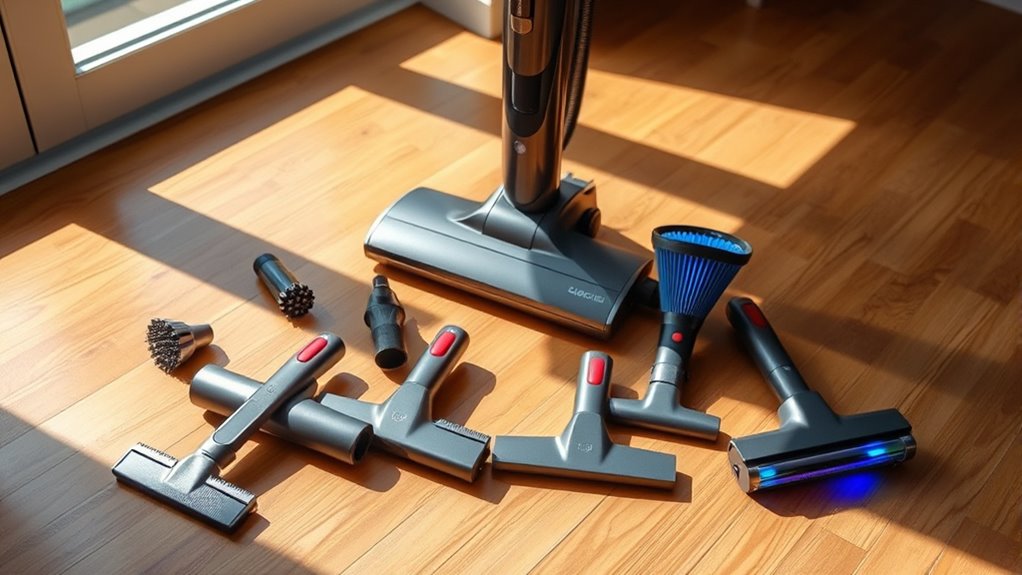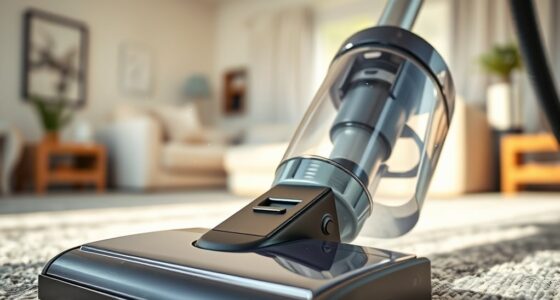Using the right vacuum attachments can remarkably reduce allergens in your home. A dusting brush targets delicate surfaces and helps remove dust mites, while a crevice tool gets into tight spaces where allergens hide. For carpets and upholstery, a motorized brush attachment efficiently captures pet hair and dirt. Don’t forget to maintain your HEPA filter for maximum effectiveness. Want to know which attachments will work best for your cleaning routine? Keep exploring to find out more.
Key Takeaways
- Dusting brushes effectively remove dust from delicate surfaces, preventing allergens from becoming airborne.
- Crevice tools access tight spaces, ensuring hidden allergens are cleaned from corners and under furniture.
- Motorized brush attachments agitate fabric fibers, efficiently removing dirt, pet hair, and allergens from carpets and upholstery.
- Specialized attachments target specific surfaces, enhancing overall allergen removal and improving cleaning routines for allergy sufferers.
- Regular maintenance of HEPA filters and attachments maximizes vacuum efficiency and maintains better indoor air quality.

When you’re battling allergens in your home, having the right vacuum attachments can make all the difference. You might not realize it, but simple tools like specialized brushes and nozzles can greatly improve your cleaning routine and reduce your allergy symptoms. One of the most vital features to look for is a vacuum that uses HEPA filters. These filters trap tiny particles like dust, pet dander, and pollen, preventing them from being released back into the air you breathe. When you invest in a vacuum with a HEPA filter, you’re taking a solid step towards a healthier living environment.
You’ll find that certain attachments are specifically designed to tackle allergens more effectively. For instance, a dusting brush attachment helps you clean delicate surfaces like shelves and electronics without scattering dust into the air. This is especially important for dust mite removal, as these pesky creatures thrive in areas with accumulated dust. By using the right tools, you can guarantee that you’re not just pushing allergens around but actually removing them from your home.
Another essential attachment is the crevice tool, which allows you to reach tight spaces where allergens like to hide—think corners, between couch cushions, and under furniture. These areas often get overlooked during regular cleaning, but they can harbor a surprising amount of dust and allergens. By using the crevice tool regularly, you can greatly decrease the number of allergens circulating in your home.
For carpets and upholstery, consider a motorized brush attachment. This tool is designed to agitate fabric fibers, pulling out dirt and allergens more effectively than standard attachments. If you have pets, this becomes even more vital, as pet hair and dander can trigger allergic reactions. Regular use of a motorized brush will help you maintain a cleaner home environment, and you’ll notice a marked reduction in allergy symptoms.
Lastly, don’t forget about maintenance. Regularly changing or cleaning your HEPA filters and vacuum attachments is essential to guarantee they work effectively. A clogged filter can do more harm than good, allowing allergens to escape back into your home. By keeping your vacuum in top shape, you’ll maximize its effectiveness in dust mite removal and overall allergen control. Additionally, using vacuum attachments designed for allergens can complement the benefits of HEPA filters, further enhancing your indoor air quality.
Frequently Asked Questions
How Often Should I Replace Vacuum Attachments for Optimal Allergen Control?
You should replace your vacuum attachments every 6 to 12 months, depending on their durability and your cleaning frequency. If you vacuum often or have pets, consider replacing them more often to maintain ideal performance. Regularly inspect your attachments for wear and tear, as damaged parts can hinder their effectiveness. Staying on top of this will help guarantee your vacuum works efficiently, reducing allergens in your home.
Can Vacuum Attachments Remove Pet Dander Effectively?
Yes, vacuum attachments can effectively remove pet dander. When you use specialized attachments designed for pet hair, they lift it from carpet fibers and other surfaces more efficiently. These tools often have rubberized surfaces or bristles that attract and trap hair and dander, preventing them from recirculating in the air. Regularly using these attachments helps keep your home cleaner and reduces allergic reactions, making it a smart choice for pet owners.
Are There Specific Attachments for Different Flooring Types?
Yes, there are specific attachments for different flooring types, like a tailored suit that fits just right. You’ll find brushes designed for carpets that agitate fibers, while hard floor attachments glide smoothly, preventing scratches. This flooring compatibility guarantees you’re making the most of your vacuum’s attachment versatility. By using the right tools, you can effectively clean various surfaces, making your cleaning routine more efficient and your home spotless.
Do Vacuum Attachments Require Special Cleaning or Maintenance?
Yes, vacuum attachments do require special cleaning and maintenance. To keep them in good shape, you should check for attachment compatibility with your vacuum model. Cleaning frequency depends on usage; generally, it’s a good idea to clean them every few weeks. Remove debris, hair, and dust buildup to guarantee peak performance. Neglecting this can lead to decreased suction and efficiency, so stay on top of it for the best results.
What Is the Best Vacuum Brand for Allergen Control Attachments?
When it comes to selecting a vacuum brand that excels in allergen control, you’ll find the likes of Dyson and Shark stand out. Their vacuum brand comparison reveals impressive allergen control features, such as HEPA filters and specialized attachments. You’ll appreciate how these brands prioritize your health, ensuring your home remains a haven of freshness. Ultimately, it’s about choosing a vacuum that not only cleans but also contributes to a healthier living environment.
Conclusion
So, if you think your vacuum’s just a glorified dirt collector, think again! With the right attachments, it can double as your personal allergen assassin. Who needs a superhero when you’ve got a hose and a brush? Embrace the power of suction and show those pesky allergens who’s boss! After all, nothing says “I love my home” quite like a dust-free zone where the only thing sneezing is your vacuum from all the hard work!









